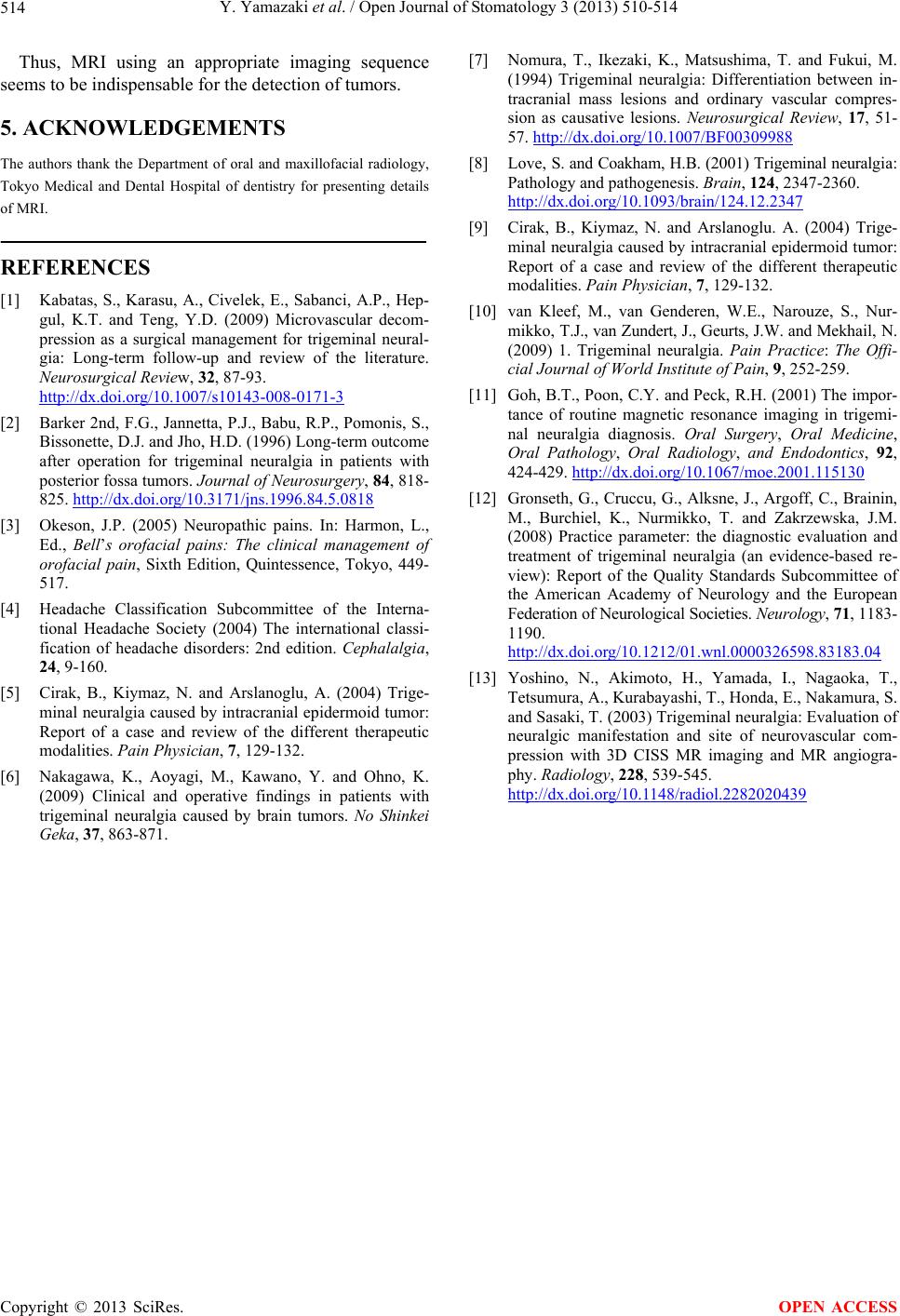
Y. Yamazaki et al. / Open Journal of Stomatology 3 (2013) 510-514
Copyright © 2013 SciRes.
514
[7] Nomura, T., Ikezaki, K., Matsushima, T. and Fukui, M.
(1994) Trigeminal neuralgia: Differentiation between in-
tracranial mass lesions and ordinary vascular compres-
sion as causative lesions. Neurosurgical Review, 17, 51-
57. http://dx.doi.org/10.1007/BF00309988
Thus, MRI using an appropriate imaging sequence
seems to be indispensable for the detection of tumors.
5. ACKNOWLEDGEMENTS
[8] Love, S. and Coakham, H.B. (2001) Trigeminal neuralgia:
Pathology and pathogenesis. Brain, 124, 2347-2360.
http://dx.doi.org/10.1093/brain/124.12.2347
The authors thank the Department of oral and maxillofacial radiology,
Tokyo Medical and Dental Hospital of dentistry for presenting details
of MRI.
[9] Cirak, B., Kiymaz, N. and Arslanoglu. A. (2004) Trige-
minal neuralgia caused by intracranial epidermoid tumor:
Report of a case and review of the different therapeutic
modalities. Pain Physician, 7, 129-132.
REFERENCES
[1] Kabatas, S., Karasu, A., Civelek, E., Sabanci, A.P., Hep-
gul, K.T. and Teng, Y.D. (2009) Microvascular decom-
pression as a surgical management for trigeminal neural-
gia: Long-term follow-up and review of the literature.
Neurosurgical Review, 32, 87-93.
http://dx.doi.org/10.1007/s10143-008-0171-3
[10] van Kleef, M., van Genderen, W.E., Narouze, S., Nur-
mikko, T.J., van Zundert, J., Geurts, J.W. and Mekhail, N.
(2009) 1. Trigeminal neuralgia. Pain Practice: The Offi-
cial Journal of World Institute of Pain, 9, 252-259.
[11] Goh, B.T., Poon, C.Y. and Peck, R.H. (2001) The impor-
tance of routine magnetic resonance imaging in trigemi-
nal neuralgia diagnosis. Oral Surgery, Oral Medicine,
Oral Pathology, Oral Radiology, and Endodontics, 92,
424-429. http://dx.doi.org/10.1067/moe.2001.115130
[2] Barker 2nd, F.G., Jannetta, P.J., Babu, R.P., Pomonis, S.,
Bissonette, D.J. and Jho, H.D. (1996) Long-term outcome
after operation for trigeminal neuralgia in patients with
posterior fossa tumors. Journal of Neurosurgery, 84, 818-
825. http://dx.doi.org/10.3171/jns.1996.84.5.0818 [12] Gronseth, G., Cruccu, G., Alksne, J., Argoff, C., Brainin,
M., Burchiel, K., Nurmikko, T. and Zakrzewska, J.M.
(2008) Practice parameter: the diagnostic evaluation and
treatment of trigeminal neuralgia (an evidence-based re-
view): Report of the Quality Standards Subcommittee of
the American Academy of Neurology and the European
Federation of Neurological Societies. Neurology , 71, 1183-
1190.
http://dx.doi.org/10.1212/01.wnl.0000326598.83183.04
[3] Okeson, J.P. (2005) Neuropathic pains. In: Harmon, L.,
Ed., Bell’s orofacial pains: The clinical management of
orofacial pain, Sixth Edition, Quintessence, Tokyo, 449-
517.
[4] Headache Classification Subcommittee of the Interna-
tional Headache Society (2004) The international classi-
fication of headache disorders: 2nd edition. Cephalalgia,
24, 9-160. [13] Yoshino, N., Akimoto, H., Yamada, I., Nagaoka, T.,
Tetsumura, A., Kurabayashi, T., Honda, E., Nakamura, S.
and Sasaki, T. (2003) Trigeminal neuralgia: Evaluation of
neuralgic manifestation and site of neurovascular com-
pression with 3D CISS MR imaging and MR angiogra-
phy. Radiology, 228, 539-545.
http://dx.doi.org/10.1148/radiol.2282020439
[5] Cirak, B., Kiymaz, N. and Arslanoglu, A. (2004) Trige-
minal neuralgia caused by intracranial epidermoid tumor:
Report of a case and review of the different therapeutic
modalities. Pain Physician, 7, 129-132.
[6] Nakagawa, K., Aoyagi, M., Kawano, Y. and Ohno, K.
(2009) Clinical and operative findings in patients with
trigeminal neuralgia caused by brain tumors. No Shinkei
Geka, 37, 863-871.
OPEN ACCESS